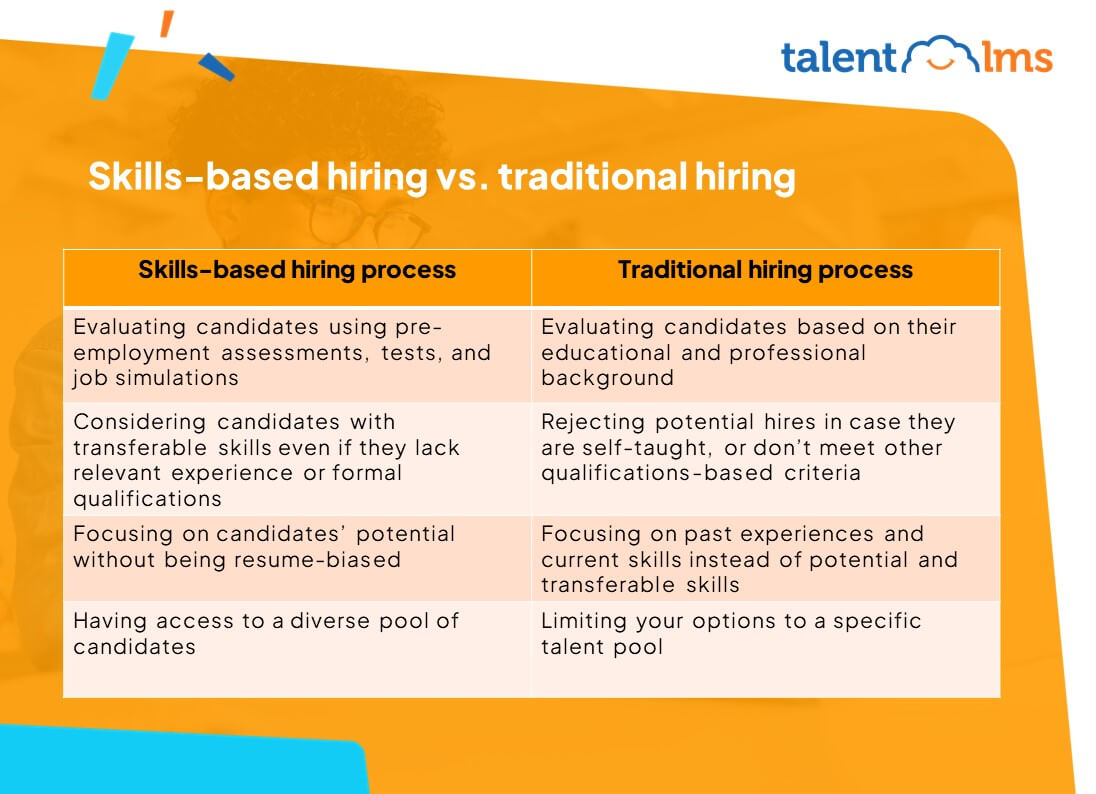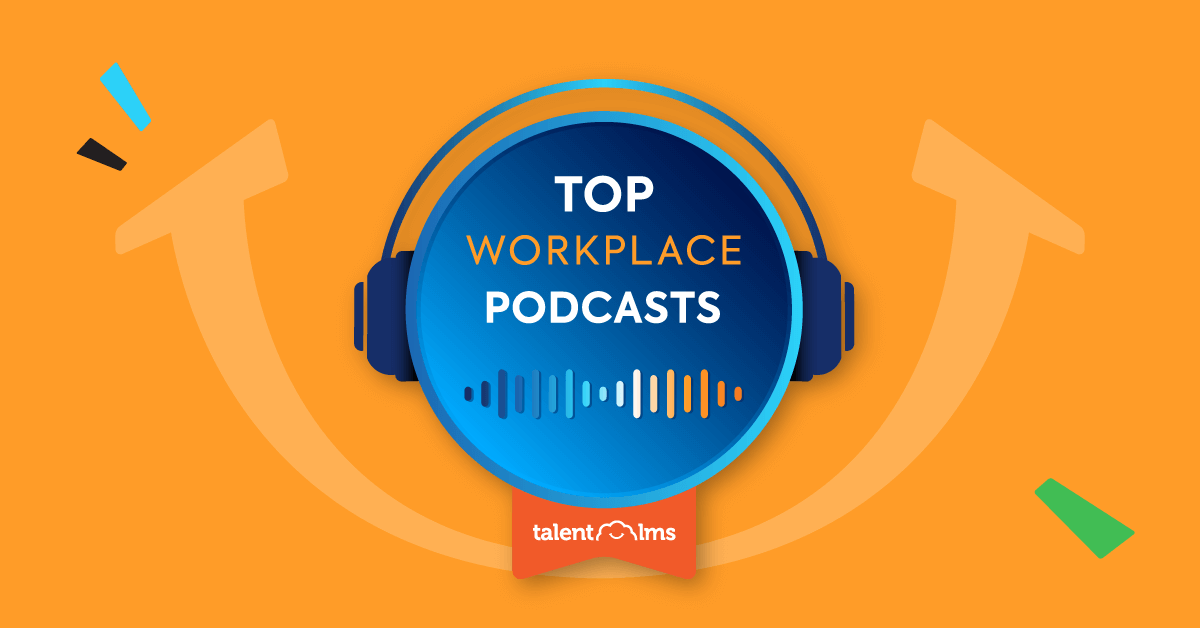The landscape of talent acquisition is changing.
Companies are focusing more on agility and innovation, shifting to hiring based on potential, rather than degrees and past experience.
For many businesses, it’s not important anymore whether candidates have a specific college degree or 10 years of experience. In fact, 76% of employers use skills-based hiring to acquire new talent and 55% use role-specific skills tests, according to TestGorilla.
Job postings on LinkedIn focus on skills and responsibilities by 21% more in the U.S., rather than qualifications. And 78% of HR professionals say the quality of their organization’s hires has improved due to their use of assessments.
After all, the goal of every organization is to attract and retain highly skilled professionals that will contribute to achieving great business outcomes.
And this is why companies are embracing skills-based hiring.
Let’s explore why this is the most forward-thinking talent acquisition practice in the modern workplace.
The power of transferable skills
Focusing on skills rather than degrees is not a compromise.
People who come from different professional backgrounds, people with untraditional or no academic background possess transferable skills that can be valuable. Even more valuable than degrees and relevant work experience.
For example, Angel Pla is the digital coach of Walmart, former veteran. He didn’t have the relevant education to perform this job role. However, because of the skills-based hiring practices that Walmart follows, he has been excelling at this position for nine years. Angel Pla explains that the core skills he uses daily are leadership, management, and problem-solving, most of which he learned while serving at the Coast Guard.
Management and HR teams saw potential in him, promoted him, and gave him the chance to thrive in the company by contributing to the teams with his skills and abilities.
The term “paper ceiling” refers to career advancement barriers that people without a college degree experience. 62% of the workforce in the U.S. fall into this category. Another term worth mentioning is STARS (Skilled Through Alternative Routes) which describes people who have learned skills through on-the-job training, military service, certificate programs, employee training, and boot camps.
Tear The Paper Ceiling is a campaign that aims to create more career opportunities for STARS workers as the paper ceiling phenomenon has proven to severely affect businesses’ DEI.
Some candidates might not be the perfect match for a job at first look. But with the power of transferable skills, people can demonstrate how they can succeed in the job.
Transferable skills highlight employees’ qualifications to become a true asset to the organization. Such skills may include:
- Teamwork
- Leadership
- Group management
- Problem-solving
- Communication
- Empathy
- Adaptability
- Digital literacy
- Critical thinking
- Innovation

Meet TalentLibrary™
A growing collection of ready-made courses that cover the soft skills
your teams need for success at work![]()

So, why are transferable skills so powerful? They hold so much power simply because they are skills that can be applied to numerous jobs and careers.
But there’s more to that.
When focusing on degrees, you’re missing out on great candidates who may lack those traditional qualifications but bring fresh perspectives due to their transferable skills. There’s an untapped pool of diverse candidates. And to reach these candidates, HR and hiring managers need to shift the hiring process, from the traditional model to a skills-based approach.
Skills-based hiring vs. traditional hiring
Companies should revisit the way they make their hiring decisions. In order to attract diverse talent, organizations should make changes to their traditional hiring process.
Let’s examine the main differences between skills-based hiring and traditional hiring with outdated criteria, to identify which changes companies should consider.

But before applying any changes to the traditional hiring process, it’s essential to consider the nature of the job role being discussed.
For example, it’s impossible to hire surgeons based solely on transferable skills. In such cases, formal qualifications are absolutely necessary, but skills-based selection could also play a major role in the final selection, too.
Why opt for skills-based hiring?
Rasty Rueff discusses on “Navigating non-linear career paths” from TalentLMS’ podcast series Keep it Simple, that different career paths make workplaces more diverse. So, employers should look at skills and experience, not just formal education, when hiring. Having advanced degrees doesn’t always mean the job will be harder.
Why should companies opt for this hiring strategy? Let’s delve into the main benefits skills-based hiring has to offer modern workplaces, and why you should consider implementing it.
1. Larger pool of talent
To this day, most HR teams and managers expect at least some kind of formal qualification from their candidates, even from their entry-level applicants.
By following a skills-based hiring approach in your organization, you widen the candidate pool. In this vast talent pool, it’s possible to discover people who might not have formal qualifications but do possess the necessary skills for the job—and can be easily trained to cover any knowledge gaps they may have. In that way, it’s much easier to fill up open job positions on any level.
2. More diversity in the workplace
As mentioned above, over half of the workforce in the U.S. don’t have a degree. And they may belong to minority or disadvantaged groups (racial or social minorities, people with disabilities, veterans, etc.)
Through skills-based hiring, employers encourage more candidates from such groups to apply for a job as skills are being emphasized, and not formal proof of qualifications. And with people from different backgrounds, organizations become more inclusive, diverse, and creative.
3. Less time-to-hire
Having the traditional hiring scenario in mind, HR teams and managers go over candidates’ skills later in the hiring process.
This is rather time-consuming, and HR teams and managers might end up having shortlisted people with degrees but not the necessary skills for the job. Instead, focusing on the skillset first, can save up time from the hiring process.
3. Reduced training costs
Imagine having hired salespeople with impressive resumes, a bunch of degrees, and other formal qualifications that lack communication and critical thinking skills. They would know all the sales methodologies and approaches, but wouldn’t necessarily know how to apply them on the job.
You would then need to set up training sessions to provide them with the necessary skills for the job, costing you time, effort, and resources. Instead, by hiring people based on their skills and not formal qualifications, you could reduce training costs and offer other opportunities for learning and development.
4. Greater employee retention
People who fit perfectly into their jobs are more engaged in their daily requirements, as well as more motivated to perform well. Employees feel more confident when they’re hired because of their abilities and feel encouraged to use them on the job.
With skills-based hiring, it’s possible for organizations to get the perfect fit right from the start, and benefit from more productive employees and lower turnover rates.
5. Better internal mobility
Skills-based hiring opens the door to internal mobility.
Dr. Michelle Weise discusses the granular skills people can offer at the workplace in The Power Skills to Future-proof Your Teams from TalentLMS’ podcast series Keep it Simple. She claims people learn a lot in unofficial settings and gain valuable skills. Which are just not codified in some type of credential. And organizations should look internally and encourage people to demonstrate, use, and develop those human skills.

Upskilling and reskilling initiatives bring growth opportunities to employees. And career growth is one of the main drivers for reducing turnover in organizations.
Plus, people who move from one department to another are more likely to create synergies between teams, thus contributing to better collaboration and higher productivity.
Upskill your employees with TalentLMS
Create online courses and give them access to an on-demand library.
The training platform that users consistently rank #1.
6. Increased continuous learning
When hiring based on people’s skills, you send a clear message to the entire organization. Your forward-thinking approach means that continuous learning is encouraged.
You don’t limit your hiring to your current needs, but rather focus on potential and growth opportunities so that your teams reach their fullest potential in their careers.
How to apply a skills-based hiring approach
What can managers and HR teams do to shift focus from the traditional hiring approach to a skills-based hiring approach seamlessly, and achieve great results?
1. Adjust job descriptions and job posts
Rethink how you create job descriptions when you start your recruitment process. Prioritize the skills which are required to do the job as well as the responsibilities of the employee.
Which are the end results you expect from the person to deliver in this role? The job description should be written with these in mind.
Linkedin’s study revealed what potential new hires look for in job descriptions on a heat map. Besides the salary and compensation, what candidates found interesting was what success would look like in the role.
2. Understand the skills needed for a role through a job analysis
HR teams should collaborate with hiring managers to gather better insights on what skills are essential for the role, as well as how these skills must be assessed. Whether these skills are technical, hard, or soft skills.
Through this analysis, talent acquisition teams will be able to conduct an effective skills assessment that will assist in finding the best fit for the role.
3. Include skills assessment into the recruitment process
It’s essential to reconsider the way organizations approach recruitment and particularly candidate interviews. What does this process currently look like, which questions are being asked to evaluate candidates, and how are they being assessed for the role?
The recruitment process with a skills-based hiring approach must include different techniques like job auditions, soft skills assessments, or virtual reality assessments.
For example, a role requires exceptional verbal communication skills. But you can’t assess this skill by looking at candidates’ qualifications or through traditional interview questions. Instead, you can include role-playing exercises during the interview or a job simulation to evaluate how candidates use their communication abilities in action.

Examples of skills-based hiring
Many employers show interest in skills-based hiring by shifting the focus on the skills required for a role, and not degrees. Let’s explore some organizations that have successfully implemented a skills-based hiring approach.
IBM invests in the future of work by tackling the credentials dilemma. Not only do they focus on hiring people from underrepresented groups based on their skill sets and not on their degrees, but they are committed to extending skills training so as to make sure they provide free education opportunities to these groups.
Another company that invests in a skills-based hiring approach is Google. Their hiring process is an important part of their culture, and they care about building an inclusive and representative workplace, beginning with hiring. Google encourages potential candidates to reflect on themselves before applying for a job role – “Your skills, interests, and goals are the result of your life, your experiences, your triumphs, and your failures. If we hire you based on your skills, we’ll get a skilled employee.”
Finally, as mentioned above, Walmart is also a fan of skills-based hiring. Throughout their careers page, it’s easy to identify how much skills and inclusion are being valued in the organization. More specifically, Walmart encourages people to join their teams by stating, “Come as you are,” and then “Learn what you need,” as they offer employees numerous training and development opportunities for lifelong learning and career growth.
Challenges in investing in skills-based hiring
Even if skills-based hiring is considered to be the future of work, it comes along with some challenges, like:
It’s hard to customize for particular job roles
There are instances where a job role requires a diverse set of skills. It’s impossible for candidates to undergo too many skills assessments during the hiring process. Also, it could be hard to assess niche-specific skills if employers don’t develop their own tests.
In this case, try a blended approach. Combine both traditional hiring and skills-based hiring practices. Evaluate portfolios of work samples or degrees, but at the same time, conduct a couple of skill assessments that will give you a better understanding of the candidates’ potential.
It’s difficult to change the traditional hiring mindset
Changing habits can always be challenging. But what if skills-based hiring is the best go-to option for your organization?
HR should educate hiring managers by conducting training on why skills-based hiring is a viable option, and by encouraging them to look beyond resumes.
Help hiring managers evaluate candidates objectively with TalentLMS
Deliver courses on reducing biases and applying hiring best practices.
Easy to set up, easy to use, easy to customize.
Skills assessments don’t always predict performance accurately
Sometimes, when a candidate performs well during an assessment, they don’t perform as expected on the actual job. This happens because there is no ecological validity in the assessment.
To tackle this challenge, try incorporating job simulations in the recruitment process to discover whether the candidate would perform well in a realistic situation that the job entails.
Assessment tools focus on hard skills
Skills-based hiring is very common in the technology field, and that’s because there is a variety of tools that examine hard skills like coding. If organizations are looking to assess soft skills, there aren’t many (reliable) assessment tools available to do the job.
In case your assessment tools for soft skills evaluation are ineffective, invest in behavioral and situational interviews which will give you valuable information about how the candidate handles their skill set.
There are budget limitations
Recruitment can be expensive, and this is why many employers are skeptical about adding an extra step in the hiring process. There is worry around wasting time, effort, and resources while preparing role-specific tests and evaluating each candidate.
However, when adopting skills-based hiring, there are more chances for organizations to find suitable candidates for the role. And faster. That happens because you may not easily find good candidates who also possess a specific degree. But if you ditch the degree requirement, then you cast a wider net. Therefore, you have a larger pool of candidates to pick your next hire from.
Also, skills-based training lowers employee turnover while increasing productivity in the future.
Looking beyond resumes for an inclusive future at work
It’s hard to predict what skills will be essential in the future.
But this means that, regardless of the hiring method, it’s crucial to maintain a growth and reskilling/upskilling mindset to be able to adjust to changes, lead innovations, and foster inclusion.
Skills-based hiring is the first step to success. It helps remove obstacles for talented candidates that might not be able to access traditional degrees, plus it helps widen the talent pool in order for organizations to find the perfect match for the job.
| Tags: hiring,HR,learning and development




